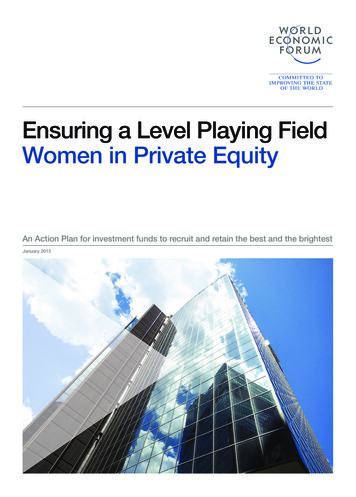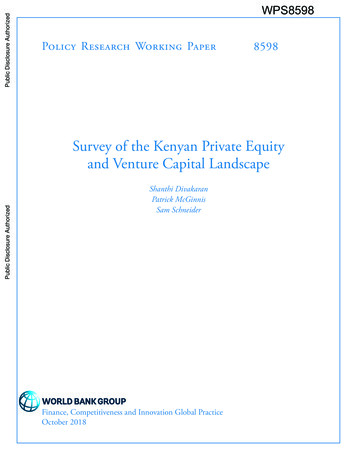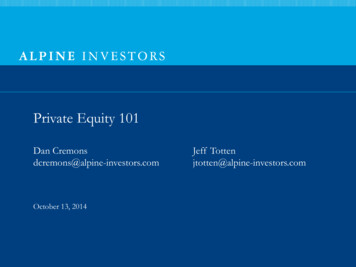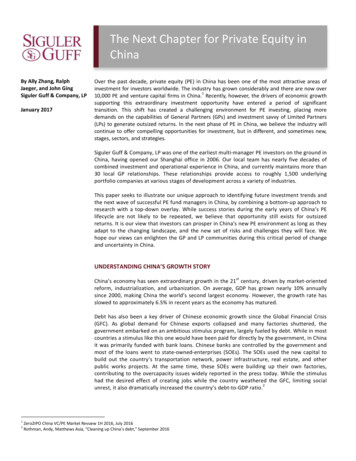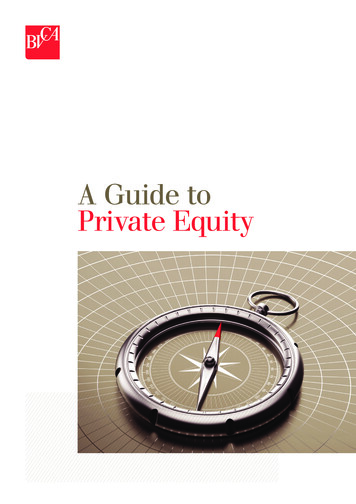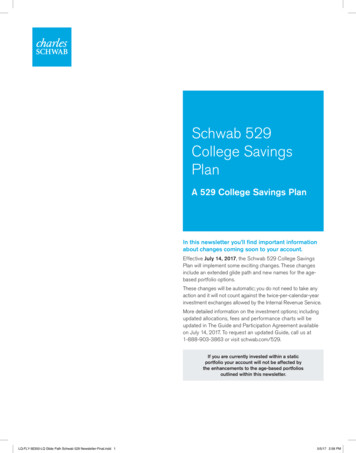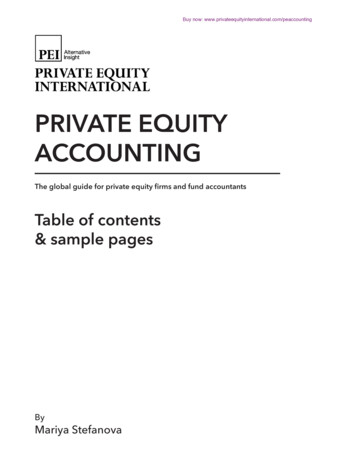
Transcription
Buy now: VATE EQUITYACCOUNTINGThe global guide for private equity firms and fund accountantsTable of contents& sample pagesByMariya Stefanova
Buy now: VATE EQUITYACCOUNTINGBy Mariya StefanovaTable of contentsForewordby Anthony Cecil, KPMG LLP &Angela Crawford-Ingle, Ambre Partners Limited1. Introduction to private equity for accountants2. Private equity structures and types of funds3. Why private equity accounting is different?4. The Limited Partnership Agreement (LPA) explained5. Fund lifecycle6. Initial, subsequent and final closings, rebalancing and equalisation7. Drawdowns8. Partner transfers9. Investments10. Valuations,by David L. Larsen, Duff & Phelps LLC11. Expenses and income12. Management fee versus Priority Profit Share (PPS)13. Distributions
Buy now: VATE EQUITYACCOUNTINGBy Mariya StefanovaTable of contents continued.14. Carried interest15. Fund financial statements format and how they are different from otherentities financial statements16. More about allocationsby Gaurav Marwah, Augentius Fund Administration LLP17. Consolidationby Angela Crawford-Ingle, Ambre Partners Limited18. Performance measurement – is it all about IRRs?by Alistair Hamilton, Inflexion Private Equity Partners LLP19. Investor reporting - accounting support for Investor Relationsby Monika Nachyla20. Private equity accounting – an auditor’s perspectiveby Nat Harper, KPMG LLP21. Some final topicsa. Accounting for other entities within the fund structureb. How different accounting platforms support private equityc. In-house vs. outsourced fund accounting
Buy now: hy is private equity accountingdifferent?By Mariya StefanovaThis chapter discusses:zz The ways private equity accounting is different from accounting for otherinvestment typeszz Factors contributing to the uniqueness of private equity accounting, including: The preferred legal form (limited partnership and equivalents) and its specific – Introductionallocations and allocation rulesLimited partnership agreement (LPA)Fund purpose, activities and structureInvestors’ needs for financial reporting informationAccounting frameworks and the ‘investor-defined accounting framework’(LPA GAAP)Accounting for a private equity fund (and the other entities within the fund structuredescribed in Chapter 2) is quite unique – not that accounting rules do not apply, theycertainly do, but due to the fact that when accounting frameworks are defined, thestandards-setters usually do not write them with private equity in mind (of course thereare exceptions, such as US GAAP11), and therefore some modifications to these rulesand accounts formats are required in order for those accounts to be useful to their user– mostly the investors.So, what is so unique about private equity accounting that sets it apart from accountingfor entities of other types of investment vehicles and other industries? If you are new toprivate equity you will be able to answer that question by the end of this chapter.In a nutshell, there are six major differentiators that separate private equity accountingfrom accounting for entities of other industries and other types of investment vehicles:1. The legal form – a limited partnership with its different investor classes (LPs, GP and FP) –and the way that this legal form is used to cater for the specific needs of the asset class.2. The fund terms laid down in the limited partnership agreement (LPA).3. The purpose and nature of the activities of the private equity fund.4. The needs of the main users of the financial statements – the investors and theirreporting requirements.5. A unique accounting framework used only in this asset class – the ‘investor-defined1In US GAAP a separate set of rules applies – the AICPA Audit and Accounting Guide for InvestmentCompanies, where accounting rules are put in the context of investment companies.31
Buy now: tion I: Chapter 3accounting framework’, also called LPA GAAP (Generally Accepted AccountingPrinciples) which is still used in certain jurisdictions (for example, the UK).The combination of these five factors, which are explained below one by one, makesprivate equity accounting unique and difficult to understand, at least at first, byaccountants from outside of the asset class. This guide sets out to give the reader, in asystematic and hopefully comprehensive way, an insight into the mechanics of privateequity accounting.Legal form– limitedpartnership (orequivalents)As explained in Chapters 1 and 2, a limited partnership (fund for joint account or othersimilar forms) is the preferred legal form for private equity funds. The ways in which thatlegal form is used to cater for the needs of the asset class, particularly the arrangementof the different classes of partners (limited partners (LP), general partner(s) (GP),founder partner (FP)), with different rights and responsibilities, are the framework for theaccounting and reporting that dictates the layout of the accounts, how the information isrecorded and what level of analysis is used.Allocations andallocation rulesThe first thing to bear in mind is that, in a limited partnership, investors (LPs) have aninterest in the partnership. The same logic applies to a corporate form, but instead ofinterest in a partnership, investors have shares. There are other types of partner. A GPacts in its capacity as a GP with its responsibility to manage the fund, but it can also be anLP/investor. In a UK partnership there may be an FP, which is basically a carried interestpartner (CIP) that can act in its capacity as such, but also, similar to the GP, may act inits capacity as an LP/investor; these different entities in the fund can be referred to as‘classes of partners’ (but sometimes I may refer to them as ‘classes of investors’). A basicpremise for the preparation and presentation of the partnership’s financial statementsis to reflect the interest of each class of partner (or shareholders in a corporate form) inthe net assets of the partnership at each reporting date, or in other words the share ofeach class of partners in all the partnership’s assets, liabilities, income and expenses (netincome) and gains or losses.The aim is also to present the return (understand the total profit and loss (P&L)) bypartner class, as well as by individual non-managing partner/investor. Therefore a fund’saccountant needs to be able to track transactions and identify balances at the partnerlevel, which is achieved by recording the transactions at that level. All the partners – LPs,GP and FP – have certain functions, rights and responsibilities within the structure, asexplained in more detail in Chapter 2. Following that logic, when recording transactionsthat stem from those functions, rights and responsibilities, these transactions should beallocated to each partner; this then allows for individual reporting on each partner interms of its share in the assets, liabilities, income, expenses and gains or losses which isultimately their share in the net assets or net asset value (NAV).From the drawdown to the distribution, from the simplest fund expense or the incomefrom interest on loan notes to the capital gain or loss on realisation of investments, thetotal amount of each of these transactions must be allocated to each individual partner32
Buy now: www.privateequityinternational.com/peaccountingWhy is private equity accounting different?in a certain way. This process is called ‘allocation’ and the ways in which accountantsallocate those amounts to each partner is by following certain rules that are usuallystipulated in the limited partnership agreement (LPA) – they are called ‘allocation rules’.Allocations and allocation rules are explained in more detail in Chapter 16.An example of how the limited partnership, as a legal form, and the way in which it isused to cater to the needs of private equity is represented in specific sections of thefinancial statements, that is, the bottom part of the profit and loss/income statementwhere the net income and gains (losses) are allocated to classes of partners. For moreanalysis, see the P&L in Appendix 4. Another example is the bottom part of the balancesheet – the partners’ accounts with the capital contribution account, loan (contribution)account, income account and capital (gains) account, which is further detailed in thestatement of changes in partners’ accounts (the ‘capital account’).These three elements of the private equity fund financial statements – bottom part ofthe balance sheet, bottom part of the P&L and capital account/partners’ accounts – arethe most prominent examples of how the concept of allocation to individual partnersmaterialises in the financial statements.The uniqueness of the asset class, fund mechanics and lifecycle and the way performanceis measured in private equity are discussed in the following section.Limitedpartnershipagreement (LPA)The second contributor to the uniqueness of private equity accounting is the termsstipulated in the LPA, which is an essential part of any fund accountant’s toolkit. Asexplained in Chapter 2, the second (although not by importance) crucial document forthe fund accountant to understand, after he or she is familiar with the fund structure, isthe LPA. Almost all the answers to questions that a fund accountant may have can beanswered by reading the LPA. These questions will typically comprise:zz What is the accounting period?zz What reports need to be provided to the investors and when should they beprovided?zz How is money drawn down and distributed from/to the partners?zz How is the waterfall/carried interest calculated?zz When and how should the partnership be dissolved?A comprehensive explanation of the LPA terms for the fund accountant is provided inChapter 4.Fund purpose,activities andstructureAs outlined in many LPAs, the purpose of the private equity fund can be describedas: ‘Carrying out the business of an investor to identify, research, negotiate, make andmonitor the progress of and sell, realise, exchange or distribute investments.”2 Theseinvestments include ordinary shares, preference shares, debentures, loan stocks and2Quote from an anonymised LPA.33
Buy now: he limited partnershipagreement explainedBy Mariya StefanovaThis chapter discusses:zzzzzzzzLimited partnership agreement (LPA)The LPA structure, including its important clausesWhere to look in the LPAImplications for accounting and reportingAs explained in Chapter 2, the second crucial document for any fund accountant tounderstand, after familiarising himself or herself with the fund structure, is the limitedpartnership agreement (LPA).What is an LPAThe LPA is the key legal document for a fund set up as a limited partnership. It sets out therelationships, rights and responsibilities of each class of partners – limited partners (LPs),general partner (GP) and, where applicable, the founder partner (FP). The LPA essentiallysets out all the rules of the fund. Anything and everything that a fund accountant needsto know should be in the LPA, although this is not necessarily always the case and thatposes some challenges for fund accountants. Therefore, a fund accountant needs tohave a thorough knowledge of the LPA of any fund he or she looks after.The partners can agree whatever commercial terms they want, as long as the LPs do nottake part in the management of the fund so as to preserve their limited liability status asexplained in Chapter 2 (with the slightly modified terms of and the extra limited liabilityshield for LLLPs, explained in the same chapter). The problem with some LPAs is thatthey are often not detailed enough, whereas some of them lack detail about importantaspects, such as allocations and even the waterfall calculation. In some cases certainparts of an LPA might even contain errors or omissions (with no offence to the lawyersintended, because they usually do a great job, but certain commercial, accounting andreporting aspects are sometime not fully addressed).A universal wisdom that I learned from a seasoned fund accountant – a partner in oneof the Big Four1 – is that you should never let a lawyer put a formula in your LPA. This isprecisely why fund sponsors, lawyers and accountants need to work together from theoutset when the LPA is being drafted to avoid making changes to the LPA later in the lifeof the fund when, for important changes, there needs to be consent from the LPs. In my1The Big Four refers to the four largest global firms offering accountancy and professional services. Thisgroup currently includes Deloitte Touche Tohmatsu, Ernst & Young, KPMG and PricewaterhouseCoopers.41
Buy now: tion I: Chapter 4experience sponsors more frequently refer to their accountants or fund administratorsfrom an early stage of the fund’s establishment to ask for advice on certain practicalaspects of the LPA.The following section provides an outline of some of the key clauses in an LPA andshould serve as an overview for new fund accountants; it contains the most importantclauses for accountants to be aware of in order to do their job properly.PartiesThis section identifies the different parties involved with, and therefore bound by, theLPA. They are usually the GP, the FP (where applicable) and the LPs. Occasionally someLPAs include other specific parties with some special rights, for example, a governmentbody or organisation participating in an infrastructure fund.Introduction(or recitals)The ‘recitals’ set out, by way of a general introduction, the reasons why the LPA is beingentered into by the parties. In the recitals, there is some historical information thatserves as a short overview of what has happened between the date the partnership wasoriginally established and the date of the relevant version of the LPA, for instance, whenthe partnership was formed, who originally formed it, which partner retired and who wasappointed instead. You will also find information on all the amended versions and therelevant dates on which the LPA has been amended, provided that you are reading asubsequent or final version. Information on initial contributions can also be found here,for example, the FP’s initial capital contribution as a carried interest partner and LP. If thefinal closing date has been extended, this information will be included here as well.Definitions andinterpretationsThe definitions are extremely important because they contain some subtle details thatcan make a significant difference when applied in practice under the terms of the LPA.The following are some of the most common and important definitions, which havethe largest impact on the accounting and reporting aspects of the fund, but this isby no means an exhaustive list. Furthermore, fund-specific definitions are sometimesencountered that need to be taken into consideration; obviously it is not possible tocover all of these here, but they are some that will serve you well in dealing with certainspecific practical accounting aspects.Accounting dateand accountingperiodIf you are uncertain about the accounting date of the fund, typically the LPA will holdthe answer for you in an unambiguous way, but what might be trickier sometimes isthat in most LPAs, the accounting period is defined as a calendar year and, althoughit may seem obvious, as fund accountants we often think of the accounting periodmore as a quarterly period, due to the industry best practice of preparing accountsand reports on a quarterly basis. However, in some cases, such as the calculation ofthe management fee/PPS with the offsetting of transaction and other fees (which, forthe management fees/PPS reduction purposes, are typically calculated based on theamounts for the previous accounting period; for more details on the management fee/PPS calculation, refer to Chapter 12), we need to consider that the management fee42
Buy now: nitial, subsequent and final closings,rebalancing & equalisationBy Mariya StefanovaThis chapter discusses:zzzzzzzzzzzzWhat is a close or closing?What is a subsequent closing?Funds with multiple closingsWhat are the implications of subsequent closings for investors?The process of equalisationThe process of rebalancingIn Chapter 2, I discussed the closed nature of the private equity funds and in Chapter 5I introduced the closing process, and now in this chapter I will discuss in more detail theaccounting implications that result from the subsequent and multiple closings.What is a closeor closing?As a reminder, a close or closing is any date on which the general partner (GP) admitsone or more additional (also called ‘subsequent closing’) partners to the fund or thatis any intake of new investors. On each closing, the GP can admit additional and/orsubsequent partners to the fund or permit previously admitted partners to increase theircommitments – both types are usually referred to as ‘subsequent-closing partners’.Some pre-closingeventsBefore admission, any new investors will need to execute and deliver certain documents,instruments and certificates with the most important ones being an application foradmission to the partnership and the execution of a deed of adherence, followed bya client due diligence (CDD) (formerly known as a KYC or ‘know your client’) processwhich could be performed by either the GP or delegated to an external service provider(for example, the fund administrator the GP has employed).It is the GP’s responsibility to make sure that the admission of any new investor will notresult in a violation of any applicable law, not just in the fund’s jurisdiction, but also in theinvestors’, for example the Financial Services and Markets Act 2000 (FSMA) in the UK orthe federal securities laws and the ERISA legislation in the US.1If it is a US fund or if there are US investors investing in the fund, the chances are thatthere would be some provisions, with regards to the admission of new investors, about1For more implications on ERISA investors please refer to Chapter 4.63
Buy now: tion I: Chapter 6the Investment Company Act and the registration of the fund under that act and theAdvisers Act and the registration of the GP, the manager or any other affiliates asinvestment advisers under that act.2Initial or firstclosingThe initial closing date, also called the first closing date, is the date on which the firstinvestors are admitted to the fund. Very often that date is indicated in the amended andrestated version of the limited partnership agreement (LPA) following that closing date,although sometimes if you are an external accountant and you are not involved in theadministration, for example if the drawdowns and other processes are kept in-house bythe private equity firm and you only prepare the accounts, it may take a little bit moreeffort to find out, but in any case you would need to know what the initial or first closingdate is, as most of the events in the fund’s lifecycle start counting from that date.Subsequent oradditional andmultiple closingsSubsequent or additional closing is a closing following the initial closing; here, referenceis made to multiple closings when there is more than one closing, or in other words,when there is(are) subsequent closing(s) following the initial closing.As usual, the first consideration for the fund accountant is to check the LPA. Typicallythere would be either a completely separate section, which might be titled with variousheadings including: subsequent-closing partners: further partners: admission of furtherpartners; or additional limited partners. Alternatively, it could be a part of a section, forexample, it could be in the same section as the partner transfers, called something suchas transfers or subsequent closing partners. As explained below, there would usually bea timeframe for the subsequent closings.A subsequent investor, also referred to as an additional investor or a further partner,is an investor admitted after the first closing date or any investor that increases itscommitment (in which case such an investor will only be a subsequent investor in respectof its increased commitment).Final closing dateThe final closing date (in some LPAs it is referred to as the final admission date) is thefinal date on which additional/subsequent investors are admitted to the fund, or onwhich increased capital commitments are accepted from existing investors.The timeframe within which the fund can have its final closing usually counts fromthe initial closing. Whereas 12 months is very common, 18 months has also becomeincreasingly common during the financial crisis, so it is important to confirm the exacttimeframe as it might be more or less than 12 months. I have seen timeframes includingnine months, six months (which is not that common), but in tough fundraising conditionsthe timeframe might be set to more than 12 months.2Please note the changes to the US Investment Advisers Act of 1940 (the Advisers Act) as a result of theDodd-Frank Act and the new exemptions and check how these changes will impact your structure. As at thetime of the publication, the US SEC has postponed the registration probably until first quarter of 2012 fromthe originally planned deadline for registration of July 21, 2011.64
Buy now: tial, subsequent and final closings, rebalancing & equalisationThe GP has the responsibility to determine that date and notify the investors aboutthe final closing date. Similar to the initial closing date, the final closing date may beindicated in the amended and restated versions of the LPA following the final closing.DocumentationWhat are the documents that you, as a fund accountant, would need to reflect the eventsthat are to be recorded as a result of a subsequent closing?zz Once again, first you will need the LPA – the LPA provides all the rules governing subsequentclosings – and timing, conditions to be met, restrictions and equalisation calculation.zz Since what really is happening at a subsequent closing is accepting new investorsor increasing the interest in the fund of existing investors, you will need the deedsof adherence/subscription documents. The deeds of adherence is basically adocument according to which investors agree to adhere to the fund’s LPA, which alsocontains some additional useful for the accountant information (for example, contactinformation, tax status, tax ID, whether the investor is an ERISA investor, and if K-1is required if the investor is a US investors). In addition to that, CDD (formerly KYC)documents, W-8, W-93 and other documents may be required.What are theimplicationsof subsequentclosings for theinvestors?There are a few implications of subsequent closings for the investors:The first implication is that subsequent investors are required to contribute to thepartnership as if they have joined the fund on day one – on the first closing date – andtherefore they will be sharing the benefits, that is, the distributions, in exactly the sameway, as if they were investors that had joined the fund at first closing.zz The second implication stems from the first one, namely, if the subsequent investorsare treated as if they have joined the fund on day one, then if there were anydrawdowns between the initial closing and the relevant subsequent closing, a trueup is required and that true-up is called equalisation. The process of equalisation willbe explained in more detail below.zz In addition to the equalisation, regardless of whether there were any drawdowns,another process is required, which is called rebalancing. The process of rebalancingwill also be explained below.EqualisationAs briefly explained above, the process of equalisation is carried out on subsequentclosings to true-up all investors as if they had joined the fund on day one, in order to beable to share the benefits (the distributions) as if they were investors that had joined thefund at first closing.3W-8 Form (for non-US investors) and W-9 (for US investors) are US tax (IRS) forms usually provided toinvestors as part of the subscription documents pack and are used when US source income is flowingoutside the US, in order to ensure that the appropriate withholding is levied on the outflow of funds. If theinvestor does not provide W-8 or W-9 form to confirm what kind of an entity it is or what tax residency statusis, the partnership would have to withhold from the investor at the maximum rate (30 percent as at thepublication) rather than a lower or even a zero rate potentially applicable in accordance with the tax treatybenefits that the relevant investor is entitled to.65
Buy now: artner transfersBy Mariya StefanovaThis chapter discusses:zzzzzzzzzzWhat is a partnertransfer?What is a partner transfer?Vital documents for fund accountants to record transactions properlyAccounting implications and the impact on financial statementsPartner transfers in specialist private equity accounting systemsSome complications and possible reasonsFollowing on from the discussion in Chapter 6 about the implications of admitting newinvestors to the fund at subsequent closings, this chapter will outline the implicationsof transferring interests in the partnership with or without admitting new investors –substitute investors – to the fund at any one time, before or after the final closing.The partner transfer is a transaction between two parties:11. A transferor (or assignor) – an existing partner to the partnership that transfers part orthe whole of its interest in the partnership to the second party.2. The transferee(s) (or assignee(s)) – one or more existing partner(s) to the partnershipor an external new substitute investor(s).The partner transfer is conducted by way of sale, exchange, assignment, pledge or any otherdisposition, typically with the prior written consent of the general partner (GP). It is subjectto certain conditions, but the GP will usually waive, in its sole discretion, any or all of thoseconditions and in many cases the other limited partners (LP) have pre-emptive rights.The following are some but far from all of the cases in which an LP may transfer all or anypart of its interest, including any interest in the capital or profits of the fund and the rightto receive distributions from the fund:zz If an LP defaults or envisages defaulting on its commitment, the GP may, usually in itssole discretion, offer the interest of that defaulting/potentially defaulting partner tothe existing partners or admit to the partnership a substitute partner(s) to assume thewhole or a portion of the defaulting partner’s commitment.zz If the GP determines that there is a reasonable likelihood of a certain LP’s participationin the fund having a material adverse effect on the GP, the fund, any portfolio company1Regardless of the fact that there may be multiple transferee transactions, the second party – the transferee– is sometimes referred to in this chapter as if it is one single party.91
Buy now: tion 1: Chapter 8or any of their respective affiliates, the LP will try to dispose of its interest – in part orin whole – in the fund.zz When, to accommodate certain legal, tax, regulatory or other considerations ofcertain investors, interests in the partnership are cancelled to be given equivalentinterests in parallel funds that have substantially the same terms as the main fund.zz For ERISA partners or public-plan partners, if a statute or regulation regarding thedefinition of plan assets changes or if the fund fails to qualify as a venture capitaloperating company (VCOC) or to satisfy the 25 percent exception in the case ofERISA partners or statute or regulation changes that make the investment illegal forpublic plan partners.zz Other cases when the GP deems the transfer is in the best interest of the partnership,GP (and/or other related entities) and/or LPs.Vital documentsto entBy now you will no doubt have figured out that the first thing that a fund accountant alwaysneeds to do is to identify the provisions in the limited partnership agreement (LPA). Partnertransfers are no exception, so in this case you need to identify the provisions that deal withthem. The LPA sets out all the rules for the transfer, such as conditions to transfer, restrictions,pre-emptive rights (if any) and other terms. The section of the LPA that deals with partnertransfers may differ between LPAs: ’transfers’ – completely dedicated to partner transfers;part of a larger section that deals with transfers and subsequent closings called ’transfersthat focus on subsequent closing partners’; ‘transfer or assignment of interests or shares’;or ‘assignment of interest or shares and resignation from the partnership’.The second task is to make sure that all other required documents are available. Whenyou have them read them carefully to identify the information required for the accountingprocesses that will be run to reflect the partner transfer.Transferagreement/deedof transfer/deedof assignmentWhatever its name, this document sets out the agreement between the transferor andthe transferee, for the transferor to transfer part or its entire interest in the partnershipto the transferee. This document grants rights to the transferee with regards to thepartnership interest being transferred and contains almost all of the information aboutthe partner transfer transactions – names of the transferor/assignor and the transferee(s)/assignee(s), amount
19. Investor reporting - accounting support for Investor Relations by Monika Nachyla 20. Private equity accounting – an auditor’s perspective by Nat Harper, KPMG LLP 21. Some final topics a. Accounting for other entities within the fund structure b. How different accounting platforms s
